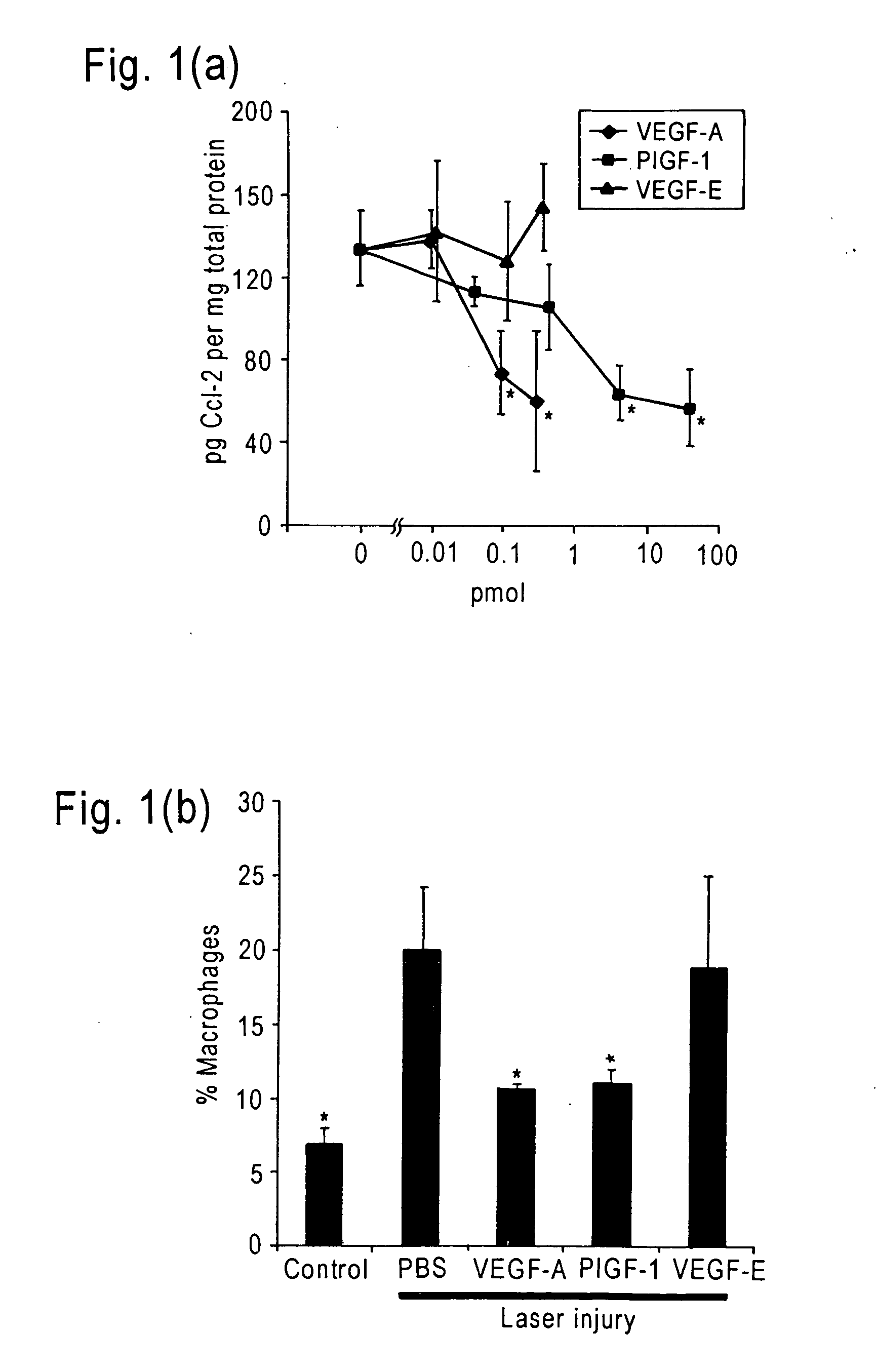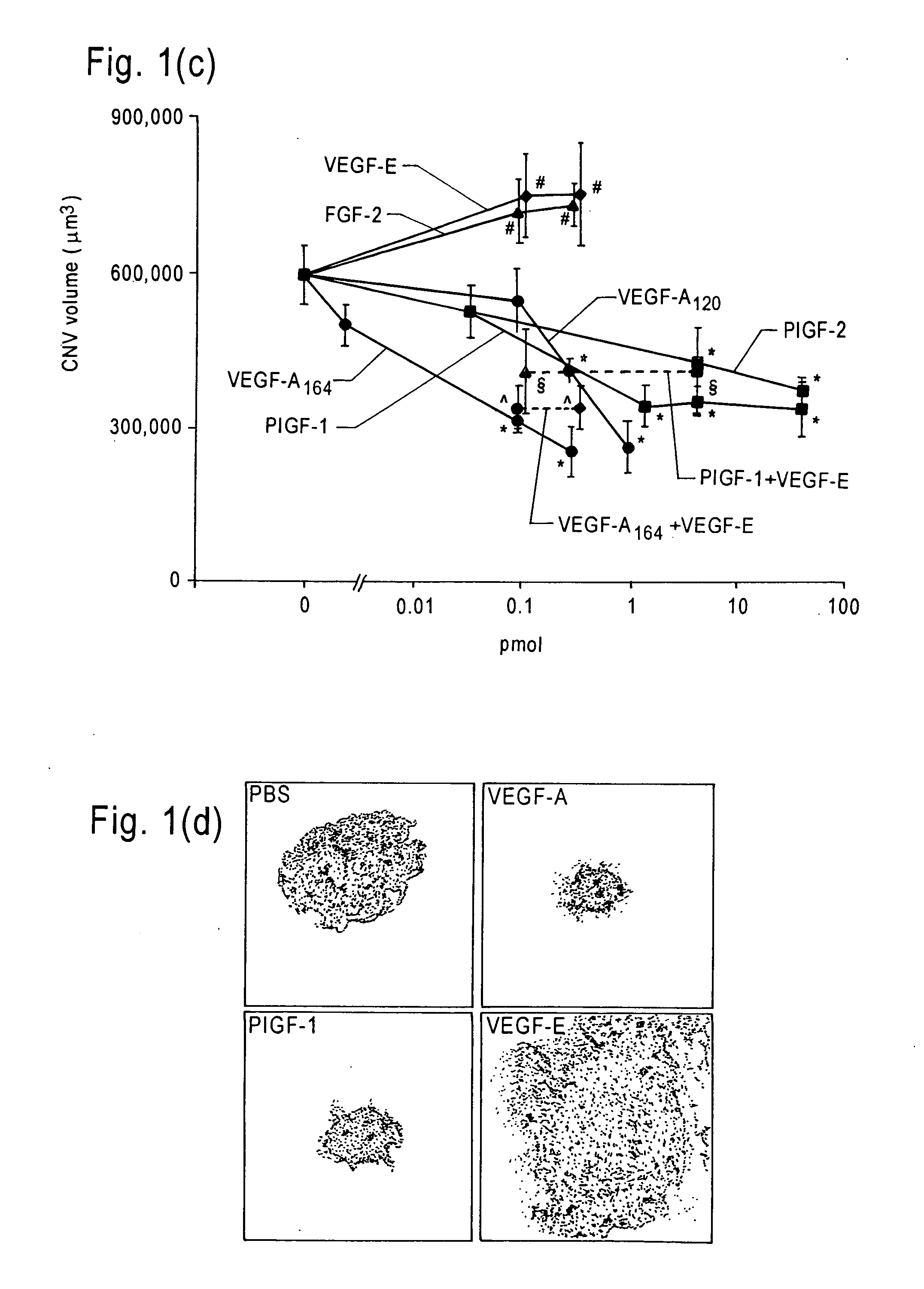VEGF-A as an inhibitor of angiogenesis and methods of using same
a technology of vegf and angiogenesis, which is applied in the field of vegfa, can solve the problems of insufficient choroidal neovascularization, vegf expression in retinal pigmented epithelial cells is not sufficient to cause choroidal neovascularization, and the data are conflicting, so as to achieve the effect of inhibiting angiogenesis and modulating angiogenesis
- Summary
- Abstract
- Description
- Claims
- Application Information
AI Technical Summary
Benefits of technology
Problems solved by technology
Method used
Image
Examples
example 1
VEGF-A Downregulates Ccl-2 and Inhibits CNV in vivo
[0119] We tested the effect of injecting murine VEGF-A164 (the murine homolog of VEGF-A165) into the vitreous cavity of mice following laser injury. Laser injury fractures Bruch membrane (BrM), the extracellular matrix between the retinal pigmented epithelium (RPE) and choroid, the highly vascular tissue beneath the RPE. The ensuing inflammation triggers proliferation of choroidal endothelial cells (CEC) that then migrate through these fractures, resulting in choroidal (subretinal) neovascularization (CNV). Ryan, S. J. Subretinal neovascularization. Natural history of an experimental model. (1982) Arch Ophthalmol 100, 1804-9; Tobe, T. et al. Targeted disruption of the FGF2 gene does not prevent choroidal neovascularization in a murine model. (1998) Am J Pathol 153, 1641-6). This process is driven by upregulated secretion of Ccl2 that peaks 2 days after injury, leading to recruitment of macrophages into the choroids that peaks 3 day...
example 2
VEGF-A Levels are Pathophysiologically Relevant
[0122] The peak VEGF-A concentration in the RPE and choroid following VEGF-A164 injection is 4-fold higher than its maximal level following laser injury alone, and rapidly declines to basal levels within one day (FIG. 1i,j). This peak level of 1.5±0.3 ng / ml is on the same order of magnitude as the VEGF-A concentration in the subretinal space, which is immediately adjacent to the RPE and choroid, of patients with retinal detachment or retinopathy of prematurity (ROP). Moromizato, Y., Hayashi, H., Kato, H., Ozaki, H. & Oshima, K. Concentration of vascular endothelial growth factor within the subretinal space and vitreous fluid in rhegmatogenous retinal detachment. (1997) Nippon Ganka Gakkai Zasshi 101, 498-502. Lashkari, K. et al. Vascular endothelial growth factor and hepatocyte growth factor levels are differentially elevated in patients with advanced retinopathy of prematurity. (2000) Am J Pathol 156, 1337-1344. CoCl2 injection led to...
example 3
VEGFR-1 Mediates Anti-Angiogenic Actions of VEGF-A
[0123] Because VEGF-A164 binds not only VEGFR-1 and VEGFR-2 but also the neuropilin (NP) receptors, we tested the effects of placenta growth factor-1 (PlGF-1), a VEGFR-1 specific ligand (Park, J., Chen, H., Winer, J., Houck, K. & Ferrara, N. Placenta growth factor. Potentiation of vascular endothelial growth factor bioactivity, in vitro and in vivo, and high affinity binding to Flt-1 but not to Flk-1 / KDR. (1994) J Biol Chem 269, 25646-25654), and VEGF-E, a VEGFR-2 specific ligand (Ogawa, S. et al. A novel type of vascular endothelial growth factor, VEGF-E (NZ-7 VEGF), preferentially utilizes KDR / Flk-1 Receptor and carries a potent mitotic activity without heparin-binding domain. (1998) J Biol Chem 273, 31273-31282), neither of which bind NP-1 or NP-2. A single intravitreous injection of PlGF-1 (40-1,250 ng) resulted in similar suppressive effects on macrophage recruitment and CNV whereas VEGF-E (4-12 ng) did not (FIG. 1c). We found ...
PUM
| Property | Measurement | Unit |
|---|---|---|
| time | aaaaa | aaaaa |
| total volume | aaaaa | aaaaa |
| composition | aaaaa | aaaaa |
Abstract
Description
Claims
Application Information
 Login to View More
Login to View More - R&D
- Intellectual Property
- Life Sciences
- Materials
- Tech Scout
- Unparalleled Data Quality
- Higher Quality Content
- 60% Fewer Hallucinations
Browse by: Latest US Patents, China's latest patents, Technical Efficacy Thesaurus, Application Domain, Technology Topic, Popular Technical Reports.
© 2025 PatSnap. All rights reserved.Legal|Privacy policy|Modern Slavery Act Transparency Statement|Sitemap|About US| Contact US: help@patsnap.com



